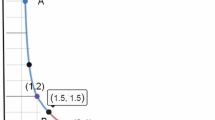Abstract
This paper attempts to provide a systematic approach to the DEA model building. To this end, we try to identify some essential aspects of DEA modelling. Three key building blocks in a DEA model are identified: they are preference order, production possibility set and performance measure. It is shown that the preferences and performance measurements used in the standard DEA models are only particular examples in this framework. It is also illustrated in this work that this methodology is useful in building new DEA models to handle nonstandard applications such as those involve non-Pareto preferences or undesirable inputs-outputs.
Similar content being viewed by others
References
Ali, A. and L.M. Seiford. (1990). “Translation Invariance in Data Envelopment Analysis.” Operations Research Letters, 10, 403–405.
Allen, K. (1998). “DEA in the Ecological Context—An Overview.” In: Working Paper in European Symposium on Data Envelopment Analysis, Fachhochschule Harz, Wernigerode.
Allen, R.A. Athanassopoulos, R.G. Dyson, and E. Thanassoulis. (1997). “Weights Restrictions and Judgements in Data Envelopment Analysis: Evolution, Development and Future Directions.” Annals of Operations Research, 66, 93–102.
Banker, R.D., A. Charnes, and W.W. Cooper. (1984). “Some Models for Estimating Technical and Scale Inefficiencies in Data Envelopment Analysis.” Management Science, 30, 1078–1092.
Charnes, A., W.W. Cooper, B. Golany, L. Seiford, and J. Stutz. (1985). “Foundations of Data Envelopment Analysis for Pareto-Koopmans Efficient Empirical Production Functions.” Journal of Econometrics, 30, 91–107.
Charnes, A., W.W. Cooper, A.Y., Lewin, and L.M. Seiford. (1994). Data Envelopment Analysis. Kluwer Academic Publishers, Dordrecht.
Charnes, A., W.W. Cooper, and E. Rhodes. (1978). “Measuring the Efficiency of Decision Making Units.” European Journal of Operational Research, 2, 429–444.
Cooper W.W., L.M. Seiford, and K. Tone. (2000). DEA Envelopment Analysis. Kluwer Academic Publishers, Boston.
Charnes, A., W.W. Cooper, Q.L. Wei, and Z.M. Huhng. (1989). “Cone Ratio Data Envelopment Analysis and Multi-Objective Programming.” Int. J. Systems. Sci., 20, 1099–1118.
Fare, R. and C.A. Lovell. (1978). “Measuring the Technical Efficiency of Production.” Journal of Economic Theory, 19, 150–162.
Ferrier, G.D., K. Kerstens, and P.V. Vorden Eeckaut. (1994). “Radial and Nonradial Technical Efficiency Measures on a Data Reference Technology.” Recherches Economiques de Louvain, 60, 449–479.
Golany, B. (1988). “An Interactive MOLP Procedure for the Extension of DEA to Effectiveness Analysis.” Journal of the Operational Research Society, 39, 725–734.
Halme, M., T. Joro, and P. Korhonen. (1999). “Value Efficiency Analysis for Incorporating Preference Information in Data Envelopment Analysis.” Management Science, 45, 103–115.
Lins, M.P.E, et al. (2003). “Olympic Ranking Based on a Zero Sum Gains DEA Model.” European Journal of Operational Research, 148, 312–322.
Liu, P.L. (1985). Multiple Decision Making. Plenum, New York.
Liu, W.B. and W. Meng. (2005). “Using DEA to Evaluate Scale Efficiency of Research Groups.” to be published in Scientific Research Management, Vol.4.
Liu, W.B. and J. Sharp. (1999). “DEA Models Via Goal Programming.” In G. Westerman, (ed.), Data Envelopment Analysis in the Public and Private Sector, Deutscher Universtats-Verlag.
Mas-colell, A., M.D. Whinston, and J.R. Green. (1995). Microeconomic Theory. Oxford University Press.
Nemhauser, G.L., A.R. Kan, and M.J. Todd. (1989). Handbooks in O.R. and Management Sciences. Vol. 1, Chapter 10, North Holland.
Pastor, J.T. (1996). “Translation Invariance in Data Envelopment Analysis.” Annals of Operations Research, 66, 93–102.
Pastor, J.T. and R.I. Sirvent. (1999). “An Enhanced DEA Russell Graph Efficiency Measure.” European Journal of Operational Research, 115, 596–607.
Podinovski, V.V. (2004). “Suitability and Redundancy of Non-Homogeneous Weight Restrictions for Measuring the Relative Efficiency in DEA.” European Journal of Operational Research, 154, 380–395.
Russell, R. (1988). “On the Axiomatic Approach to the Measurement of Technical Efficiency.” In: W. Eichhorn (ed.), Measurement in Economics. Heidelberg, Physica-Verlag, pp. 207–217.
Scheel, H. (1998). “Negative Data and Undesirable Outputs in DEA.” Working Paper in EURO Summer Institute.
Seiford, L.M. (1996). “Date Envelopment Analysis: Evolution of the State-of-the-art (1978–1998).” Journal of Productivity Analysis, 7, 99–137.
Thanassoulis, E. (2001). Introduction to the Theory and Applications of Data Envelopment Analysis. Kluwer Academic Publishers, Boston.
Thanassoulis, E. and R.G. Dyson. (1992). “Estimating Preferred Target Input-Output Level Using Data Envelopment Analysis.” European Journal of Operational Research, 56, 80–97.
Wei, Q.L. and G. Yu. (1997). “Analysis the Properties of K-cone in Generalized DEA Model.” Journal of Econometries, 80, 63–84.
Zhu, J. (1996). “Data Envelopment Analysis with Preference Structure.” Journal of the Operational Research Society, 47, 136–150.
Zhu J. (2002). Quantitative Models for Performance Evaluation and Bench-Marking: DEA with Spreadsheets and DEA Excel Solver. Kluwer Academic Publishers, Boston.
Zieschang, K. (1984). “An Extended Farrell Efficiency Measure.” Journal of Economic Theory, 33, 387–396.
Author information
Authors and Affiliations
Corresponding author
Rights and permissions
About this article
Cite this article
Liu, W., Sharp, J. & Wu, Z. Preference, Production and Performance in Data Envelopment Analysis. Ann Oper Res 145, 105–127 (2006). https://doi.org/10.1007/s10479-006-0042-7
Published:
Issue Date:
DOI: https://doi.org/10.1007/s10479-006-0042-7




